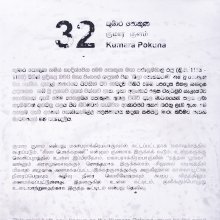Ala, Aḷa, Āla, Āḻā: 22 definitions
Introduction:
Ala means something in Hinduism, Sanskrit, Buddhism, Pali, Marathi, Jainism, Prakrit, Hindi, biology, Tamil. If you want to know the exact meaning, history, etymology or English translation of this term then check out the descriptions on this page. Add your comment or reference to a book if you want to contribute to this summary article.
Ala has 20 English definitions available.
The Sanskrit term Aḷa can be transliterated into English as Ala or Alia, using the IAST transliteration scheme (?).
Alternative spellings of this word include Aala.
Images (photo gallery)
Languages of India and abroad
Sanskrit dictionary
[Deutsch Wörterbuch]
Source: Cologne Digital Sanskrit Dictionaries: Böhtlingk and Roth Grosses Petersburger WörterbuchAla (अल):—n.
1) Stachel des Scorpions [Hemacandra’s Abhidhānacintāmaṇi 1211.] —
2) = āla, = haritāla Auripigment [Ratnamālā im Śabdakalpadruma] und [Scholiast] zu [Amarakoṣa 2, 9, 104.]
--- OR ---
Āla (आल):—
1) n. a) Laich oder Ausspritzungen giftiger Thiere [Suśruta 2, 257, 17. 296, 13. 297, 20.] [Kauśika’s Sūtra zum Atuarvaveda 51.] Vgl. ala 1. und ālākta . — b) gelber Arsenik, Auripigment [Amarakoṣa 2, 9, 104.] [Hemacandra’s Abhidhānacintāmaṇi 1059.] [Anekārthasaṃgraha 2, 474.] manaḥśilāla [Suśruta 2, 109, 12. 298, 4. 325, 16.] Vgl. ala 2. und haritāla . — c) Verstümmelung von ālaya in antarāla . —
2) adj. nicht klein (analpa) [Hemacandra’s Anekārthasaṃgraha] Diese Bed. des Wortes hat man in ālāsya (s. d.) gesucht.
--- OR ---
Ala (अल):—
1) vgl. āla [1]).
--- OR ---
Āla (आल):—
3) m. Nomen proprium eines Affen [Kathāsaritsāgara 57, 136.]
Source: Cologne Digital Sanskrit Dictionaries: Sanskrit-Wörterbuch in kürzerer FassungAla (अल):—n. —
1) Stachel des Scorpions. Vgl. aḍa in āḍa. —
2) = āla , haritāla Auripigment.
--- OR ---
Āla (आल):——
1) *Adj. nicht klein , — gering. —
2) m. Nomen proprium eines Affen. —
3) n. — a) Laich oder Ausspritzung eines giftigen Thieres. — b) Auripigment.
Sanskrit, also spelled संस्कृतम् (saṃskṛtam), is an ancient language of India commonly seen as the grandmother of the Indo-European language family (even English!). Closely allied with Prakrit and Pali, Sanskrit is more exhaustive in both grammar and terms and has the most extensive collection of literature in the world, greatly surpassing its sister-languages Greek and Latin.
See also (Relevant definitions)
Starts with (+1509): Aalaapak, Al-amarcelvan, Al-amarkatavul, Al-ankatu, Al-ppara, Ala de chinaca, Ala de murcielago, Ala nao, Ala panai, Ala-abagama, Ala-enyi, Ala-neredu, Ala-sandi, Alaa, Alaa-patli, Alaadana, Alaakrut, Alaaulada, Alaba, Alabala.
Ends with (+9980): Aabala, Aaduthoda pala, Aaku paala, Aala, Aala aala, Aalapala, Aanebyala, Aattukanala, Aattukottappala, Abaddala, Abaddhamala, Abaddhamandala, Abagala, Abahala, Abajala, Abala, Abalabala, Abalagopala, Abanala, Abatamala.
Full-text (+623): Alam, Alankarana, Alamdhana, Alamkarmina, Al, Alamjivika, Alampashu, Alamkumari, Alambhushnu, Alamkara, Alampurushina, Alamgamin, Alamtama, Alammanas, Alamkriti, Alamkarya, Alamutaiyon, Alamjusha, Alampurva, Alamprajanana.
Relevant text
Search found 169 books and stories containing Ala, Ālā, Āḷā, Āḷa, Aḷa, Āla, Alā, Āḻa, Āḻā, Āḷ-ā, Al-a, Aalaa, Azha, Aazhaa; (plurals include: Alas, Ālās, Āḷās, Āḷas, Aḷas, Ālas, Alās, Āḻas, Āḻās, ās, as, Aalaas, Azhas, Aazhaas). You can also click to the full overview containing English textual excerpts. Below are direct links for the most relevant articles:
Vakyapadiya of Bhartrihari (by K. A. Subramania Iyer)
Verse 3.14.459-460 < [Book 3 - Pada-kāṇḍa (14): Vṛtti-samuddeśa (On Ccomplex Formation)]
Verse 3.3.80 < [Book 3 - Pada-kāṇḍa (3): Sambandha-samuddeśa (On Relation)]
Brihad Bhagavatamrita (commentary) (by Śrī Śrīmad Bhaktivedānta Nārāyana Gosvāmī Mahārāja)
Verse 2.4.263 < [Chapter 4 - Vaikuṇṭha (the spiritual world)]
Verse 2.2.15 < [Chapter 2 - Jñāna (knowledge)]
Verse 1.7.99 < [Chapter 7 - Pūrṇa (pinnacle of excellent devotees)]
Garga Samhita (English) (by Danavir Goswami)
Verse 1.17.1 < [Chapter 17 - Description of the Yogurt Theft]
Verse 1.16.51 < [Chapter 16 - Description of Śrī Rādhikā’s Wedding]
Verse 2.16.36 < [Chapter 16 - The Worship of Tulasī]
Sahitya-kaumudi by Baladeva Vidyabhushana (by Gaurapada Dāsa)
Text 7.10 < [Chapter 7 - Literary Faults]
Text 10.136 < [Chapter 10 - Ornaments of Meaning]
Text 10.195 < [Chapter 10 - Ornaments of Meaning]
Tiruvaymoli (Thiruvaimozhi): English translation (by S. Satyamurthi Ayyangar)
Pasuram 1.9.2 < [Section 9 - Ninth Tiruvaymoli (Ivaiyum avaiyum)]
Pasuram 5.10.6 < [Section 10 - Tenth Tiruvaymoli (Piranta arum)]
Pasuram 3.2.1 < [Section 2 - Second Tiruvaymoli (Munnir nalam)]
Kathasaritsagara (the Ocean of Story) (by Somadeva)
Chapter LVII < [Book X - Śaktiyaśas]
Chapter LXXXV < [Book XII - Śaśāṅkavatī]
Chapter XC < [Book XII - Śaśāṅkavatī]
